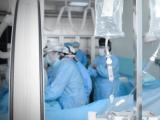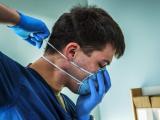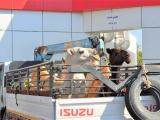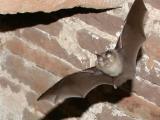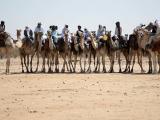Six more MERS-CoV cases were reported today, three each in Saudi Arabia and the United Arab Emirates (UAE), as the springtime surge of illnesses continued, though at a more modest pace than it showed through most of April and early May.
Also today, the United Nations Food and Agriculture Organization (FAO) appealed for an urgent increase in research on MERS-CoV (Middle East respiratory syndrome coronavirus) in animals, including a systematic hunt for animal and environmental sources of human infections.
Cases in Saudi hot spots
Saudi Arabia's Ministry of Health (MOH) reported one MERS case each in Jeddah, Mecca, and Medina, three cities that have seen plenty of MERS activity lately.
The cases involve a 46-year-old man in Jeddah with no symptoms, a 19-year-old man with diabetes who is in an intensive care unit in Mecca, and a 20-year-old woman in Medina with no symptoms. The 46-year-old and the woman had contact with other MERS patients; both are in home isolation.
The 19-year-old apparently acquired his infection in the hospital, as he was hospitalized for other medical reasons on May 17 and experienced respiratory symptoms May 23.
The MOH also reported one death in a previous case, that of a 34-year-old man in Jeddah whose illness was reported Apr 24. Four other MERS patients were released from hospitals in Mecca and Riyadh today.
Today's report raises Saudi Arabia's MERS count to 554 cases and 178 deaths.
WHO details UAE cases
The new cases in the UAE were reported today by the World Health Organization (WHO), following its receipt of a report from UAE officials 2 days ago. All three cases were in Abu Dhabi.
One case is in a 71-year-old man who has several preexisting illnesses and has been hospitalized since Feb 11, the WHO reported. He got sick with a fever on May 4 and tested positive for MERS-CoV 3 days later. He had had contact with another MERS case-patient, a 39-year-old female healthcare worker whose case was reported to the WHO on May 11.
The second case involved a 26-year-old man whose infection was detected on May 8 through general screening at his (unnamed) workplace, though he had had no exposure to other MERS patients and no symptoms on the day of screening. He had had contact with cows and sheep but not camels, nor had he consumed any raw camel products, the WHO said. For isolation purposes, he was hospitalized from May 8 to 14.
In the third case, a 36-year-old man got sick on May 2 and was hospitalized 5 days later, the WHO said. He tested positive on May 9 and then recovered and was released May 12. He had preexisting illnesses, but he had no exposure to other MERS patients, animals, or raw camel products.
The three infections raise the WHO's MERS count to 635 cases with 193 deaths. The number includes 17 cases that Saudi Arabia reported from May 16 to 18.
Meanwhile, the European Centre for Disease Prevention and Control (ECDC) today put its own MERS count at 658 cases and 204 deaths. The numbers are listed in the agency's weekly Communicable Disease Threats Report.
The ECDC count, which doesn't include the latest Saudi cases, lists the Saudi tally at 541 cases and 160 deaths. It shows the UAE as having 67 cases and 9 deaths, the second-highest totals.
FAO wants more animal research
The FAO's call for more MERS-CoV research came after a regional technical consultation in Oman, the agency said in a statement today.
Participants noted the recent increase in cases in the Arabian Peninsula and the suspicion that camels are the primary source of human cases, the FAO said. The experts recommended:
- Raising public awareness of MERS-CoV
- Urgent investment in research and surveillance of animals
- A systematic search for potential sources of human infection from animal sources or the environment
- Joint efforts and coordination among public health authorities
Many camels in the Middle East carry the virus or have antibodies that suggest past exposure to it, but no one has yet figured out exactly how it spreads from camels to humans. Experts have been calling for case-control investigations and other studies to help answer that question and related ones.
"There is an urgent need to focus investigations on the epidemiology of MERS-CoV in animal species, to prevent human primary infections and to avoid putting other people in danger," Juan Lubroth, DVM, PhD, the FAO's chief veterinary officer, said in today's statement.
"By better understanding the epidemiology, we can provide the necessary guidelines to avoid spillover from animals to humans and protect the camel or other animal industries from potential negative consequences," he said.
In addition to more research, the FAO called for several steps to help limit the spread of MERS-CoV:
- Increased biosecurity precautions at farms and border crossings
- An emphasis on personal hygiene for people who work with livestock
- Greater region-wide information sharing and closer coordination to manage risks posed by the movement of livestock
- Possible use of animal passports or certificates for racing camels
- Engagement of the private sector, such as racing associations, breeding enterprises, and meat-packing operations
Participants in the technical meeting included the World Organization for Animal Health (OIE), the WHO, the Gulf Cooperation Council, and experts who are currently collaborating with researchers and authorities of the region, the FAO said.
The meeting also drew public health and veterinary authorities and other specialists from a dozen countries: Ethiopia, Egypt, Bahrain, Jordan, Kuwait, Qatar, Oman, Palestine, Saudi Arabia, Sudan, United Arab Emirates, and Yemen.
OIE camel report
In other news, Omani officials submitted to the OIE a report on MERS-CoV infections in five camels, which appears to match a media report published 2 days ago about five infected racing camels in the country. Both appear to match up with a Eurosurveillance report that was published Apr 24 and described the detection of MERS-CoV in 5 of 76 camels from around Oman.
The new OIE report said the camels had no clinical signs of illness and that humans with exposure to the camels were tested and found free of the virus. Testing was done by the University of Veterinary Medicine in Vienna.
Oman has had two human MERS cases, according to today's ECDC communicable disease report.
See also:
May 23 Saudi MOH statement on 3 new cases
May 23 WHO statement on UAE cases
Saudi MOH page with case count
May 23 FAO statement
May 23 ECDC report
May 23 Oman OIE report on five infected camels
May 21 CIDRAP News story covering camels in Oman
Apr 24 Eurosruveillance report on Oman camel findings
Apr 24 CIDRAP News item on Oman camels


